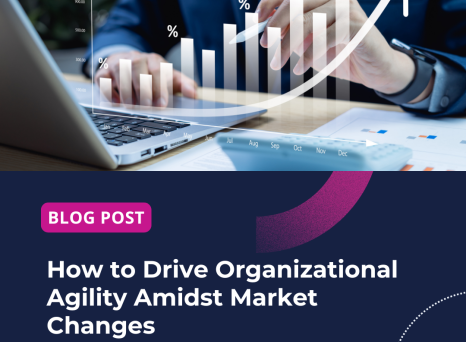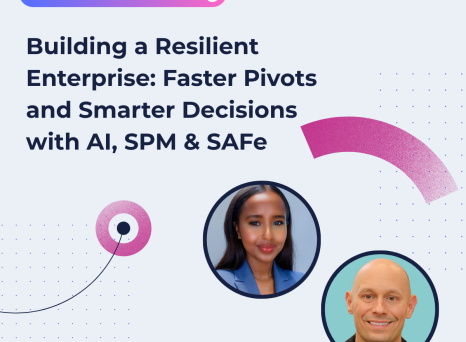This is the second installment in our series revisiting some of the key messages from Margo's webinar. Read the first article on the Role of the PMO: Help bridge the Agile expectations gap here.
Agile methodologies were born as a team level method for bringing speed and nimbleness to software development work. As Agile was gradually expanded to an ever increasing number of industries and functions within companies, the question of expanding Agile to the whole organization (and not just discrete functions within the company) became increasingly important. This lead to the birth of a whole new set of methodologies: Enterprise Agile Frameworks, the best known of which is the Scaled Agile Framework, or ‘SAFe'.
In this extract from our Webinar “How Agile PMOs can support Financial Planning“, Margo Visitacion, Vice President and Principal Analyst with Forrester, one of the leading analyst IT advisory firms, presents the results of a recent study that looked at how widely Agile techniques are in reality applied inside companies, and how many of them have started scaling Agile to the Enterprise.
Transcript below
[Margo] Organizations over the last 20 years, companies have scaled Agile horizontally. They've added more and more teams to be able to deliver you know, potentially deliver faster. But they're not seeing the business value being returned.
The next step now is taking Agile to scale so that you can build Agility within the entire organization. And enterprise level Agility is new, but it is expanding.
We're seeing that about 20% of the respondents to our surveys have adopted Scaled Agile Framework or SAFe. 19% employ Large Scale Scrum or LeSS. 10% employ Disciplined Agile Delivery 2.0 that focuses on taking a disciplined team approach. And raising it up to the planning, product planning, and portfolio planning levels. So 56% have adopted Agile at the team level.
We then asked the same respondent body. How many of you have taken Agile to an enterprise level? And 49% responded that there was some sort of formal Agile adoption at a broader than team level. With SAFe being the most frequently adopted framework, and I can say anecdotally in the interactions I have with our clients on a day to day basis that SAFe is the preferred framework for most organizations.
[Matt] Yeah, we're seeing that too. And I should note, that's part of what drove Planisware to include support for Scaled Agile Framework in our 6.3 release earlier this year. But that's an important number, 46% give or take are actually using one of these Scaled or large-scale approaches at least sometimes, right?
[Margo] Yeah, and I think in the reality what I have seen is that organizations are taking little bits of all of the frameworks that are out there.
These are by no means the only frameworks that are targeted at taking Agile beyond the individual or multiple team level, and taking it to the Enterprise level. There's also, Nexus is another framework that's coming into its own right now as an Enterprise framework that comes out of the Scrum.org world. And I think that what we see is most organizations are taking what works for them from all of the frameworks that are out there. And adapting it in order to adopt Enterprise Agility.
But even with that, scaling has its challenges, Matt. I mean over half say lack of buy-in for behavioral change. That's the most significant challenge for an organization is that you aren't just expecting your developers to change. But you're really been expecting your overall organization to think differently about how they plan and deliver products.
A third of them cite incompatibility of existing budgeting processes. When you put those two elements together, that is a real stumbling block. That's a significant barrier to getting the level of organizational and process change that you need in order to be able to make the transition. Yet, we still see a good percentage of companies sticking to the small scale effort at the product level.
And it drops down when organizations are trying to prioritize at a value stream level.
Only 20% of the organizations that we surveyed said that they had scaled to the enterprise level, where it had impacted their strategic planning. They've transformed their strategic planning, and their financial planning in order to be able to build business agility throughout the entire organization.
[/tab]
As Margo highlights, scaling Agile to the Enterprise has quite a few challenges:
- Lack of buy-in for behavioral change is a classic challenge that appears in pretty much all significant organizational transformation projects. But it is especially difficult to handle when you are looking to change the mindset of the whole organization, such as when scaling Agile to the Enterprise.
- Incompatibility of traditional fiscal-year budgeting highlights the fundamental shift from a mindset where everything is pre-planned in advance, to a mindset where the organization is continually taking action to adapt to changes in its environment.
- Classic budgeting processes are so strongly ingrained in business culture that it is very difficult for many to even imagine an alternative way of budgeting.
- Limitations to the scope of implementation of Agile shows how mindsets that are not firmly in the mainstream at individuals' level can be difficult to extend to higher hierarchical levels, and how the Agile community is still coming to grips with how to do this.
Proven scaled agile frameworks, such as SAFe, go some way to overcome these challenges.
Stay tuned! Through the month of August, we will revisit some of the key messages from Margo's webinar, so be sure to come back and read the next instalment!


